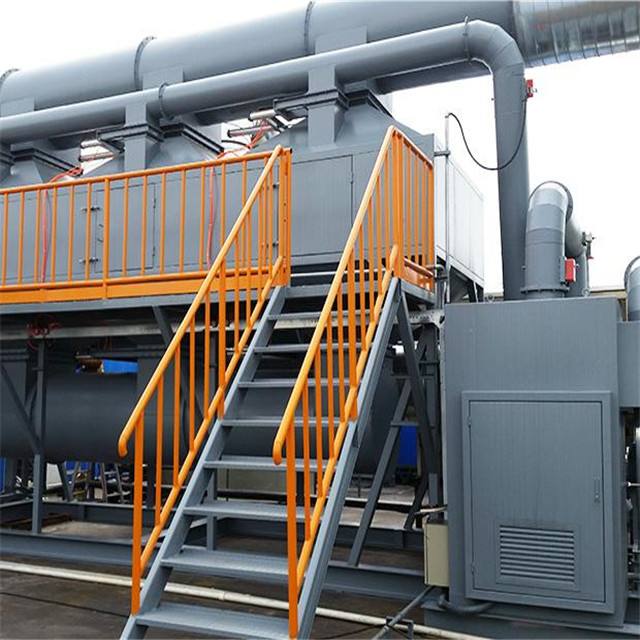Prefabricated eco-house, fast assembly
Steel pipes, Laser machinery, UAV
Water/gas treatment, Cooling water

Prefabricated eco-house, fast assembly
Steel pipes, Laser machinery, UAV
Water/gas treatment, Cooling water


Our company's treatment of organic waste gas is mainly to adopt the optimum process to adsorb, filter and purify the organic waste gas produced in the industrial production process.
Our company can deal with organic waste gas including formaldehyde organic waste gas treatment, benzene series organic waste gas treatment, acetone butanone organic waste gas treatment, ethyl acetate waste gas treatment, oil mist organic waste gas treatment, furfural organic waste gas treatment, styrene, acrylic acid organic waste gas treatment, resin organic waste gas treatment, additive organic waste gas treatment, paint mist organic waste gas treatment. Air purification methods for treating organic matter such as hydrocarbon, hydrogen, oxygen and so on.
1. Condensation method: The organic waste gas is directly introduced into the condenser, which can be absorbed, absorbed, unloaded and separated to reuse valuable organic matter. This method is suitable for high concentration, low temperature and low air volume of organic waste gas. It needs auxiliary refrigeration equipment. It is mainly used in pharmaceutical and chemical industries, but seldom used in printing enterprises.
2. Adsorption method:
(1) Direct adsorption method: organic waste gas can be absorbed by activated carbon, which can reach more than 95% purification rate. The equipment is simple and the investment is small. However, the frequent replacement of activated carbon increases the working procedures of loading and unloading, transportation and replacement, which leads to the increase of operating costs.
(2) Adsorption method: organic waste gas is adsorbed by fibre activated carbon, and desorbed and regenerated by superheated steam after approaching saturation.
(3) Adsorption-catalytic combustion method: This method combines the advantages of adsorption method and catalytic combustion method. A new type of adsorption material (honeycomb activated carbon) is used to adsorb, and hot air is introduced for desorption and analysis after approaching saturation. After desorption, exhaust gas is introduced into catalytic combustion bed for flameless combustion, which is thoroughly purified, and hot gas is recycled in the system, thus greatly reducing energy consumption. This method has the characteristics of stable and reliable operation, less investment, lower operation cost and convenient maintenance. It is suitable for the treatment of high air volume and low concentration waste gas. It is a mature and practical method for the treatment of organic waste gas in China at present.
3. Direct combustion method: using auxiliary fuels such as gas or fuel to burn, heating mixed gases, so that harmful substances can be decomposed into harmless substances under the action of high temperature. This method is simple in process, low in investment, suitable for high concentration and small air volume exhaust gas, but it requires high safety technology and operation.
4. Catalytic combustion method: the waste gas is heated by catalytic combustion and converted into harmless and odorless carbon dioxide and water; this method has low ignition temperature, energy saving, high purification rate, convenient operation, less floor area and large investment, and is suitable for high temperature or high concentration organic waste gas.
5. Absorption method: Physical absorption is generally used, that is, the exhaust gas is introduced into the absorption liquid to be purified, and then heated, analyzed and condensed after the absorption liquid is saturated. This method is applicable to the treatment of the exhaust gas with atmospheric, low temperature and low concentration, but it needs to be equipped with heating and analysing device, which has large volume and high investment.
6. Nano-micro-electrolysis oxidation method: nano-micro-electrolysis purification technology uses piezoelectric materials processed at nano-scale. Under certain humidity conditions, nano-micro-electrolysis materials can be generated by Micro-electrolysis electric field to ElectroSorb and release a large number of hydroxyl anions to purify aerobic pollutants in the gas. It can not only remove most organic substances in the air, but also can separate them. Inorganic odor such as ammonia nitrogen and hydrogen sulfide.
7. Thermal combustion method: The use of RTO regenerative thermal oxidation furnace for organic waste gas treatment can achieve the dual effect of high efficiency and energy saving. It is suitable for treating organic waste gas in a wide range and has high efficiency. RTO equipment has been widely used in coating, printing, spraying, medicine and other industries.
Copyright All Rights Reserved @Shanghai Chemmah Industrial Co., Ltd.
Address: No. 528, North Yanggao Rd, Pudong Dist, 200137, Shanghai, China
Email: sales@chemmah.com
Tel and WhatsApp: +86 158 6847 7948